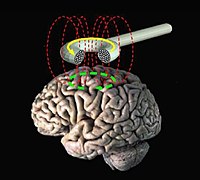
Photo from wikipedia
BackgroundDeep brain stimulation (DBS) has a good prospect for treating many brain diseases. Recent studies have shown that axonal activation induced by pulse stimulations may play an important role in… Click to show full abstract
BackgroundDeep brain stimulation (DBS) has a good prospect for treating many brain diseases. Recent studies have shown that axonal activation induced by pulse stimulations may play an important role in DBS therapies through wide projections of axonal fibers. However, it is undetermined whether the downstream neurons are inhibited or excited by axonal stimulation. The present study addressed the question in rat hippocampus by in vivo experiments.MethodsPulse stimulations with different frequencies (10–400 Hz) were applied to the Schaffer collateral, the afferent fiber of hippocampal CA1 region in anaesthetized rats. Single-unit spikes of interneurons and pyramidal cells in the downstream region of stimulation were recorded and evaluated.ResultsStimulations with a lower frequency (10 or 20 Hz) did not change the firing rates of interneurons but decreased the firing rates of pyramidal cells (the principal neurons) significantly. The phase-locked firing of interneurons during these stimulations might increase the efficacy of GABAergic inhibitions on the principal neurons. However, stimulations with a higher frequency (100–400 Hz) increased the firing rates of both types of the neurons significantly. In addition, the increases of interneurons’ firing were greater than the increases of pyramidal cells. Presumably, increase of direct excitation from afferent impulses together with failure of GABAergic inhibition might result in the increase of pyramidal cells’ firing by a higher stimulation frequency. Furthermore, silent periods appeared immediately following the cessation of stimulations, indicating a full control of the neuronal firing by the stimulation pulses during axonal stimulation. Furthermore longer silent periods were associated with higher stimulation frequencies.ConclusionsLow-frequency (10–20 Hz) and high-frequency (100–400 Hz) stimulations of afferent axonal fibers exerted opposite effects on principal neurons in rat hippocampus CA1. These results provide new information for advancing deep brain stimulation to treat different brain disorders.
Journal Title: BioMedical Engineering OnLine
Year Published: 2019
Link to full text (if available)
Share on Social Media: Sign Up to like & get
recommendations!